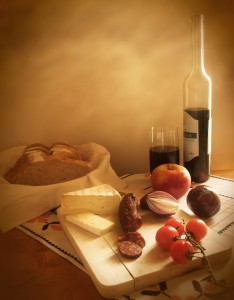 There really are a few ground rules in wine and food pairing, well not really “rules” but more like advice to keep in mind.
There really are a few ground rules in wine and food pairing, well not really “rules” but more like advice to keep in mind.
Follow the logic of the recipe. If a dish contains a certain red or white wine or even beer it generally makes sense to pair the same or a similar bottle with it. If your recipe is a sweet chocolate dessert with raspberries and cherries move in the same progression with a sweet red wine. If the pasta sauce calls for a few dashes of dry red or white wine the same will most likely match the dish.
Put out of your mind most of the rules you’ve heard. “Red wine with red meat” and “white wine with fish” worked for past dining rules but with today’s food fusions it does not always hold true. The only advice most experts agree on is to remember to drink dry wines before sweet wines, light-bodied wines before full-bodied and your wine must always be sweeter than your dessert.
Some foods and wines naturally flatter each other. These are classics for a reason – the match rarely fails. Apple or pear tarts and dessert wines, truffles or mushrooms and pinot noir, lobster and white Burgundy, roasted meats and most red wines, oysters and Champagne, Stilton cheese and port, goat cheese and sauvignon blanc and chilled dry fino sherry with roasted nuts.
Respect tradition – but not unquestioningly. Many countries, Italy and France to name a couple, have been pairingwines with certain dishes for centuries. There may be other pairings but why struggle to find new ones when they have already been perfected.
Chicken is much more than just chicken. Very rarely do we eat simple plain chicken dishes without a sauce or roasting, grilling or basting method. The starting point for chicken pairings can be found in the sauce or marinade. There’s quite a contrast between a delicate cream mushroom sauce and Thai green curry chicken, so consider the overall dish and not simply the chicken. (Same applies to most meat pairings.)
Don’t forget the sides. Generally most vegetables accompanying the meal won’t be powerful enough to dominate the main dish. But if your sides feature strong flavors such as onions, spicy salsas, cabbage or peppers you may need a more full-bodied wine to compete with the flavors.